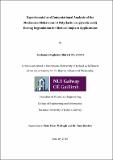| dc.contributor.advisor | McHugh, Peter | |
| dc.contributor.advisor | Rochev, Yury | |
| dc.contributor.author | Neghabat Shirazi, Reyhaneh | |
| dc.date.accessioned | 2016-04-25T14:49:44Z | |
| dc.date.issued | 2016-01-25 | |
| dc.identifier.uri | http://hdl.handle.net/10379/5707 | |
| dc.description.abstract | Biodegradable polymers such as PLGA have been used in a wide range of biomedical applications due to their hydrolytic degradation and biocompatibility. The mechanical performance of biodegradable polymers during degradation is strongly influenced by the degradation rate. The size dependent degradation mechanisms in these polymers lead to different degradation rates which make significant differences in the mechanical properties of different sized medical device components. Therefore, a clear understanding of the degradation behaviour and the mechanical performance of PLGA material during degradation is required.
In this thesis, the mechanical properties of PLGA materials prepared by solvent casting and compression moulding are evaluated using the nanoindentation technique. The measured elastic modulus and hardness are strongly depth dependent for both forms of the material, for indentations less than 3000 nm. The mechanical properties of PLGA material are significantly influenced by the material processing method. The solvent-cast material is more elastically compliant and plastically softer than the compression-moulded material and it also shows lower work hardening characteristics.
Changes in the mechanical properties of PLGA material under simulated physiological degradation conditions are evaluated. The relationship between the changes in the molecular weight and the Young’s modulus of PLGA material is established. It is shown that the PLGA mechanical properties during degradation do not decrease until the number average molecular weight of the polymer chains reaches a critical molecular weight of 1500 g mol-1. The experimental observations demonstrate that there is no significant difference in the degradation rate and the changes in the mechanical properties of PLGA thicker than 120 μm. It is shown that the material processing methods considered here do not have a significant effect on the degradation rate and the mechanical performance of PLGA material.
A computational modelling framework is developed to predict the degradation behaviour and the changes in the mechanical properties of PLGA material during degradation. The degradation behaviour is predicted using both analytical and numerical solutions. When applied to PLGA films, semi-analytical solution cannot capture the differences in degradation rates for films of thickness above 25 μm. When applied to PLGA scaffolds, architecture of the scaffold does not have a significant influence on the degradation rate, but it determines the initial stiffness of the scaffold. The size of the scaffold strut controls the degradation rate and the mechanical collapse. A critical length scale due to competition between diffusion of degradation products and autocatalytic degradation is determined to be in the range 2-100 μm. Below this range, slower homogenous degradation occurs; however, for larger samples faster autocatalytic degradation occurs. The experimental observations for the degradation rate and the mechanical performance of PLGA materials support the computational modelling predictions.
In conclusion, the use of experimental testing methods and computational modelling in this thesis has led to an improved understanding of the mechanical performance of solvent-cast and compression-moulded PLGA materials with different thicknesses during degradation. | en_IE |
| dc.rights | Attribution-NonCommercial-NoDerivs 3.0 Ireland | |
| dc.rights.uri | https://creativecommons.org/licenses/by-nc-nd/3.0/ie/ | |
| dc.subject | Degradation | en_IE |
| dc.subject | Computational Modelling | en_IE |
| dc.subject | Poly(lactic-co-glycolic acid) | en_IE |
| dc.subject | Mechanical Behaviour | en_IE |
| dc.subject | Biomedical engineering | en_IE |
| dc.subject | Biomechanics | en_IE |
| dc.title | Experimental and computational analysis of the mechanical behavior of poly(lactic-co-glycolic acid) during degradation for medical implant applications | en_IE |
| dc.type | Thesis | en_IE |
| dc.contributor.funder | Programme for Research in Third-Level Institutions (PRTLI) Cycle 5 | en_IE |
| dc.contributor.funder | European Regional Development Fund (ERDF) | en_IE |
| dc.description.embargo | 2017-04-25 | |
| dc.local.final | Yes | en_IE |
| nui.item.downloads | 483 | |


